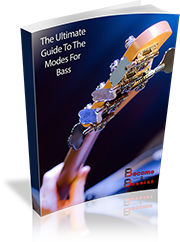Have you ever come across a chord progression ‘in the wild’ and been completely stumped as to what you could play over it?
Sure – you might be able to scrape by if you just stuck to root notes, but what if you needed to come up with a more creative bass line, or your own bass fills – or even take a bass solo…
That’s exactly what happened when a student of mine came up against this chord progression:
Em7 – Am7 – C7 – B7
What would you play over this?
Now there is no single ‘correct’ answer to this – there are quite a few possibilities! Sometimes, even playing things that are ‘wrong’ theoretically, can still sound good.
Today though, I want to share with you a 2-part formula that you can use to make very good choices when it comes to playing over more complicated chords and you only need to know 2 things to make it work.
- The notes of each chord you’re playing
- The notes of the key you’re in
With just these 2 pieces of information, you can make more inventive bass lines, create your own fills, or even improvise using some really cool sounds.
Check out the lesson here:
Video Not Showing Up Here? Watch On YouTube

Stop Struggling With The Modes On bass
FREE - Download the 16-page Ultimate Guide To The Modes Of The Major Scale For Bass and:
- Get a full explanation of the modes in simple, easy-to-understand terms
- Discover how the modes REALLY work and how they're related to different chords
- Learn how to use the modes, and where you can use each of them
- Download the free PDF guide plus 24 practice tracks that will have you using the modes TODAY
By the way, this video isn’t just about playing over that single chord progression from above. It’s about the method you can use to think through any tricky chord progressions and make great note choices.
If you find that this is a little bit over you head at the moment though, make sure to download the Ultimate Guide To The Modes On Bass using the form above. It’s completely free and the ideas in this lesson will likely make a lot more sense to you after you’ve gone through the guide.
In fact, Andy – the student who asked the question that prompted this lesson – was going through the guide when he asked me about mapping these modes to different chords. It’s just that he had stumbled upon a chord progression that used chords from outside the key.
Good luck with the lesson and happy playing!
Cheers,



Luke,
Thank you so very much for answering my question about matching modes to chords. It seems every answer opens up a whole new field of questions, which is equally inspiring and intimidating.
Is there a specific order in which we should be learning . . . everything: notes on neck, modes, scales, chords, circle of fifths, etc. mastering one before moving forward? Or is bouncing around working on bits and pieces of each (like herding sheep) an acceptable approach? I seem to be taking this second approach (what do I feel like working on today?) and while I’m not mastering any one aspect (yet) I do feel I’m slowly learning and improving.
Thank you again for making it so enjoyable.
Cheers,
Andy